Shivaram Rajguru | |
|---|---|
 Rajguru on a 2013 stamp of India | |
| Born | Shivaram Hari Rajguru 24 August 1908 |
| Died | 23 March 1931 (aged 22) |
| Cause of death | Execution by hanging |
| Nationality | Indian |
| Occupation | Revolutionary |
| Organization | HSRA Hindustan socialist Republican organisation |
| Movement | Indian Independence movement |
| Criminal charges | Murder of P. Saunders and chhanan Singh |
| Criminal penalty | Capital punishment |
| Criminal status | Executed |
Shivaram Hari Rajguru (24 August 1908 – 23 March 1931)[1][2] was an Indian revolutionary from Maharashtra (then Bombay Presidency), known mainly for his involvement in the assassination of a British police officer named John Saunders. He was an active member of the Hindustan Socialist Republican Association (HSRA) and on 23 March 1931, he was hanged by the British government along with his associates Bhagat Singh and Sukhdev Thapar.
Early life
Rajguru was born on 24 August 1908 at Khed to Parvati Devi and Harinarayan Rajguru in a Marathi Deshastha Brahmin family. Khed was located at the bank of river Bheema near Pune. His father died when he was only six years old and the responsibility of the family fell on his elder brother Dinkar. He received primary education at Khed and later studied in New English High School in Pune. He joined Seva Dal at a young age.
Revolutionary activities
He was a member of the Hindustan Socialist Republican Association, who wanted India to be free from British Raj by any means possible.[2]
Rajguru became a colleague of Bhagat Singh & Sukhdev Thapar, and took part in the assassination of a British police officer, J. P. "John" Saunders, at Lahore on 17 December 1928. Their actions were to avenge the beating of Lala Lajpat Rai by the police while on a march protesting the Simon Commission; Lala Lajpat Rai died a fortnight after the Saunders assassination.[3]
Legacy
Rajgurunagar
His birthplace of Khed was renamed as Rajgurunagar in his honour.[2] Rajgurunagar is a census town in Khed tehsil of Pune district in state of Maharashtra.[4]
Rajguru Wada

Rajguru Wada is the ancestral house where Rajguru was born. Spread over 2,788 sq m of land, it is located on the banks of Bhima river on Pune-Nashik Road. It is being maintained as a memorial to Shivaram Rajguru. A local organization, the Hutatma Rajguru Smarak Samiti (HRSS), hoists the national flag here on Republic Day since 2004.[5]
College
Shaheed Rajguru College of Applied Sciences for Women is located in Vasundhara Enclave, Delhi, and is a constituent college of Delhi University.[6]
See also
References
- ↑ Verma, Anil (15 September 2017). RAJGURU – THE INVINCIBLE REVOLUTIONARY. Publications Division Ministry of Information & Broadcasting. ISBN 978-81-230-2522-3.
- 1 2 3 "Remembering Shivaram Hari Rajguru on his birthday". India Today. 24 August 2015. Retrieved 28 May 2018.
- ↑ "National Martyrs Memorial Hussainiwala". Firozepur district official website. Retrieved 27 May 2018.
- ↑ "Rajgurunagar Population Census 2011". 2011 Census of India. Retrieved 28 May 2018.
- ↑ "Freedom fighter Rajguru's wada". DNA India. 21 September 2013. Retrieved 27 May 2018.
- ↑ "Shaheed Rajguru College of Applied Sciences for Women". Official website of college. Retrieved 28 May 2018.
Further reading
- Noorani, Abdul Gafoor Abdul Majeed (2001) [1996]. The Trial of Bhagat Singh: Politics of Justice. Oxford University Press. ISBN 0195796675.